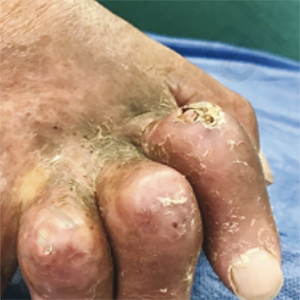Peripheral neuropathy in leprosy: Clinical manifestations and disability in a Colombian national referral center

HTML: 114
All claims expressed in this article are solely those of the authors and do not necessarily represent those of their affiliated organizations, or those of the publisher, the editors and the reviewers. Any product that may be evaluated in this article or claim that may be made by its manufacturer is not guaranteed or endorsed by the publisher.
The aim of the paper was to describe the neurological features of the physical examination in patients with Hansen’s disease who were treated in Bogotá, Colombia. We carried out a descriptive study of all patients with a Hansen’s disease diagnosis treated at a referral center between 2003-2018. There were 327 eligible electronic health records (EHRs) with a final sample of 282 subjects. Leprosy was most common in males (57.45%), median age at the diagnosis was 54 years, and lesions of the lower limbs were more common (75.1%). The median time from disease onset to consult was 12 months. Most of them were classified as having lepromatous leprosy (39.7%). Pain over the median nerve trunk was the most common manifestation of disease (28%), followed by pain over the radial trunk (22%). Sensitive alterations were more common than motor ones. Specifically, the posterior tibial nerve was affected in nearly half of subjects. Dual impairment was more common in the ulnar nerve (13.8%). Some disability was apparent in 23.8% of subjects; predominantly grade 1 disability. Findings regarding age, leprosy type, and the frequency of individual nerve compromise were consistent with reports from other countries. Nerve trunk thickening was infrequent, which might be a consequence of subjectiveness in the examination and sample differences in sex distribution, degree of disability and time since disease onset. The frequency of morbidity and disability found in this sample, though low when compared with other series, fails to meet public health goals, including those limiting disability in younger subjects.
World Health Organization. Global Leprosy (Hansen Disease) Update, 2019: Time to Step-up Prevention Initiatives. World Health Organization; 2020:417-440. Accessed December 7, 2020. https://apps.who.int/iris/handle/10665/334141
Instituto Nacional de Salud. Lepra en Colombia 2019.; 2020:30. Accessed December 7, 2020. https://www.ins.gov.co/buscador-eventos/BoletinEpidemiologico/2020_Boletin_epidemiologico_semana_3.pdf
Fadul Pérez SE. Lepra Periodo IV, Colombia, 2019. Instituto Nacional de Salud; 2019:16. https://www.ins.gov.co/buscador-eventos/Informesdeevento/LEPRA%20SEMESTRE%20I%202019.pdf
Penna MLF, Penna GO, Iglesias PC, et al. Anti-PGL-1 Positivity as a Risk Marker for the Development of Leprosy among Contacts of Leprosy Cases: Systematic Review and Meta-analysis. PLoS Negl Trop Dis 2016;10:e0004703.
Kumar V, Sachan T, Natrajan M, Sharma A. High resolution structural changes of Schwann cell and endothelial cells in peripheral nerves across leprosy spectrum. Ultrastruct Pathol 2014;38:86-92.
Pandhi D, Chhabra N. New insights in the pathogenesis of type 1 and type 2 lepra reaction. Indian J Dermatol Venereol Leprol 2013;79:739-49.
Eichelmann K, González González SE, Salas-Alanis JC, Ocampo-Candiani J. Leprosy. An update: definition, pathogenesis, classification, diagnosis, and treatment. Actas Dermosifiliogr 2013;104:554-563.
Nascimento OJM. Leprosy neuropathy: clinical presentations. Arq Neuropsiquiatr 2013;71:661-6.
Lau KHV. Neurological Complications of Leprosy. Semin Neurol 2019;39:462-71.
Berkowitz AL, Raibagkar P, Pritt BS, Mateen FJ. Neurologic manifestations of the neglected tropical diseases. J Neurol Sci 2015;34920-32.
Sindic CJM. Infectious neuropathies. Curr Opin Neurol 2013;26:510-5.
Brandsma JW, Van Brakel WH. WHO disability grading: operational definitions. Lepr Rev 2003;74:366-73.
Gehlenborg N. UpSetR: A More Scalable Alternative to Venn and Euler Diagrams for Visualizing Intersecting Sets; 2019. https://CRAN.R-project.org/package=UpSetR
R Core Team. R: A Language and Environment for Statistical Computing. R Foundation for Statistical Computing; 2020. https://www.R-project.org/
Moschioni C, Antunes CM de F, Grossi MAF, Lambertucci JR. Risk factors for physical disability at diagnosis of 19,283 new cases of leprosy. Rev Soc Bras Med Trop 2010;43:19-22.
Guerrero MI, Muvdi S, León CI. Retraso en el diagnóstico de lepra como factor pronóstico de discapacidad en una cohorte de pacientes en Colombia, 2000 - 2010. Rev Panam Salud Pública 2013;33:137-43.
Aben-Athar CYUP, Lima SS, Ishak R, Vallinoto ACR. Assessment of the sensory and physical limitations imposed by leprosy in a Brazilian Amazon Population. Rev Soc Bras Med Trop 2017;50:223-8.
Bandeira SS, Pires CA, Quaresma JAS. Nerve Damage in Young Patients with Leprosy Diagnosed in an Endemic Area of the Brazilian Amazon: A Cross-Sectional Study. J Pediatr 2017;185:143-8.
Shumet T, Demissie M, Bekele Y. Prevalence of Disability and Associated Factors among Registered Leprosy Patients in All Africa Tb and Leprosy Rehabilitation and Training Centre (ALERT), Addis Ababa, Ethiopia. Ethiop J Health Sci 2015;25:313-20.
de Paula HL, de Souza CDF, Silva SR, et al. Risk Factors for Physical Disability in Patients With Leprosy: A Systematic Review and Meta-analysis. JAMA Dermatol 2019;155:1120-8.
World Health Organization. Global Leprosy Strategy 2016–2020. Accelerating towards a Leprosy-Free World. Monitoring and Evaluation Guide. 1ra ed. Regional Office for South-East Asia, World Health Organization; 2017. Accessed November 23, 2020. https://apps.who.int/iris/handle/10665/254907
Santos VS, de Matos AMS, de Oliveira LSA, et al. Clinical variables associated with disability in leprosy cases in northeast Brazil. J Infect Dev Ctries 2015;9:232-8.
Sarker UK, Uddin MJ, Chowdhury R, et al. Clinical Profile of Peripheral Neuropathy in Leprosy. Mymensingh Med J MMJ 2015;24:671-8.
Dos Santos AR, Silva PR de S, Steinmann P, Ignotti E. Disability progression among leprosy patients released from treatment: a survival analysis. Infect Dis Poverty 2020;9:53.
van Brakel WH, Nicholls PG, Das L, et al. The INFIR Cohort Study: investigating prediction, detection and pathogenesis of neuropathy and reactions in leprosy. Methods and baseline results of a cohort of multibacillary leprosy patients in north India. Lepr Rev 2005;76:14-34.
Jain S, Visser LH, Praveen TLN, et al. High-Resolution Sonography: A New Technique to Detect Nerve Damage in Leprosy. PLoS Negl Trop Dis 2009;3:e498.
Gómez L, Rivera A, Vidal Y, et al. Factors associated with the delay of diagnosis of leprosy in north-eastern Colombia: a quantitative analysis. Trop Med Int Health 2018;23:193-8.
PAGEPress has chosen to apply the Creative Commons Attribution NonCommercial 4.0 International License (CC BY-NC 4.0) to all manuscripts to be published.





 https://doi.org/10.4081/dr.2021.9308
https://doi.org/10.4081/dr.2021.9308



